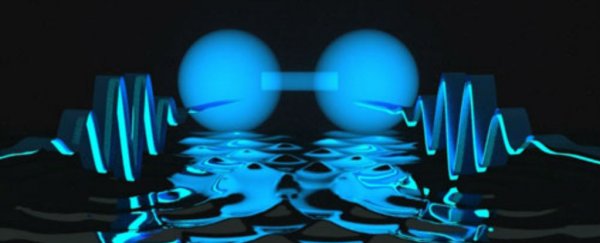Physicists have just gotten us a little closer to the dream of building objects out of pure light - hello, lightsabers - by figuring out how to join weightless light particles together to form a kind of 'two-atom molecule' with its own, strange type of force.
"It's not a molecule per se, but you can imagine it as having a similar kind of structure," one of the researchers, Alexey Gorshkov from the University of Maryland in the US said in a press release. "We're learning how to build complex states of light that, in turn, can be built into more complex objects. This is the first time anyone has shown how to bind two photons a finite distance apart."
Before you get too excited, the technique is purely theoretical at this stage, but it shows how two light particles - or photons - can travel in waves towards each other before being locked together at just a short distance apart. This would allow them to travel together at all times, with a set distance between them.
The idea is based on previous research that showed how two photons could be joined - one superimposed on top of the other - as they travelled through a gas. By adjusting certain aspects of the binding process, Gorshkov and his colleagues have now repositioned the photons to be side-by-side as they travel, just like how two hydrogen atoms sit next to each other in a hydrogen molecule.
So when can we build things out of it? The challenge in actually putting this technique into practice is creating the conditions needed to bind the photos together.
For example, when scientists first achieved photon-binding back in 2013, they had to fire pairs of photons - blue laser light with the specific wavelength of 479 nm - through an ultracold gas made from rubidium atoms. This slowed them down and facilitated an attraction between the two and caused the photons to stick together and become quantum-mechanically entangled. And figuring out how to arrange all of this in the handle of a lightsaber isn't exactly feasible… yet.
Hamish Johnston from Physics World explains:
"Getting photons to stick together is not easy because they normally pass through each other without interacting. However, a photon has an associated electromagnetic field that can modify its surrounding medium. These changes can affect nearby photons and create an effective interaction between them. Although this effect is usually tiny, the interactions can be significant if the medium is chosen carefully."
A more likely application, says Gorshkov, is in computing, as scientists around the world race to develop computer chips that can deliver information at light-speed. "Light is the fastest thing you can use to transmit information," says Rajesh Menon from the University of Utah in the US, who has been working on a new type of silicon chip for light-based computers. "But that information has to be converted to electrons when it comes into your laptop. In that conversion, you're slowing things down. The vision is to do everything in light."
By binding and entangling photons, scientists could turn them into information processors, which means that final, time- and energy-sapping step of converting the light beams that carry our phone messages and other data into electrons can be completely bypassed. "They're massless and fly at the speed of light," Gorshkov says of photons. "Slowing them down and binding them may show us other things we didn't know about them before."
The research will be published in the upcoming edition of Physical Review Letters, but is now available online at arXiv.org.
